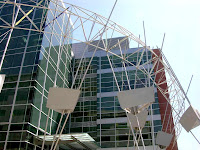Outrage channeled into activism
Given the good works inspired by Ben Linder, it's fitting he will be remembered Friday in an event marking the 20th anniversary of his death.
Linder, 27, of Portland, was killed April 28, 1987 in Nicaragua by U.S.-backed, anti-Sandinista forces while helping build a hydroelectric plant as a volunteer in a rural northern region near the Honduran border.
Ben Linder (left) working on his first hydroelectric project in Nicaragua.
His death -- at the time, he was the only American killed by the Contras -- galvanized opposition to U.S. intervention in Nicaragua. The attention helped raise awareness of the Contra war and its human costs after Linder became a victim of U.S. efforts to help overthrow the elected Sandinista government.
In the months after Linder was killed, family members -- mother, Elisabeth; father, David (he died in 1999); and siblings, John and Miriam -- and four friends and co-workers from Nicaragua scattered across the U.S. in a 7-month speaking tour. It launched a campaign that raised $800,000 over 11 years.
Yet, even as political events that surrounded Linder's death fade with time, family members are committed to a belief that Linder's life -- and death -- is as relevant today as it was two decades ago.
"We want to share Ben's example because we think it's a good one," John Linder said.
"He knew he was in a dangerous situation, and he decided to stay because he identified with the people he was working with. And that's something that speaks in many ways to the deepest values of most Americans, who would like to do something to help others and don't often get the chance to do it on as, perhaps, large a stage as Ben."
Elisabeth Linder said the remembrance of her son's death is community-based and internationally centered, citing work in Nicaragua by Green Empowerment, a Portland-based nonprofit.
Elisabeth Linder, mother of Ben, and her son John will be part of a remembrance Friday marking the 20th anniversary of Ben's death. "I love to talk about Ben because he was such a positive character," Elisabeth says. "He was fun and funny."
"It's considerably more than the family," she said. "No. 1, it's the fact that the work in Nicaragua continues . . . and makes a difference there. That people continue to be dedicated down there. The foundation, after we did the fundraising, was then taken over by Green Empowerment. And their work has expanded beyond Nicaragua."
Money raised by family and friends helped build several projects in the Jinotega region of Nicaragua where Linder was killed. Among them is a 230-kilowatt hydroelectric plant finished in 1994 in San Jose de Bocay.
Earlier this year, a 930-kilowatt plant was completed in El Bote. The $3 million project will provide electricity for 12,000 people when it begins operation. Once a development loan is paid off in about 13 years, the plant is expected to generate $250,000 in yearly revenue by selling surplus power.
In Portland, Susan Bloom administers the Ben Linder Scholarship Fund of Oregon. Each year since 2002, the $1,500 award has helped send at least one Portland Community College engineering student to a two-week program in Tlaxco, Mexico.
"They teach many of the things that Ben Linder was working for as an engineer: appropriate technology and stewardship of the land," Bloom said.
Green Empowerment, a Portland-based nonprofit, works in Nicaragua with Atder-BL, or Association of Rural Development Workers-Benjamin Linder. Atder-BL coordinates and oversees the Linder-inspired hydroelectric plants and other projects, including installation of drinking water systems and protection of watersheds being built in the region.
The Linders are especially grateful to Rebecca Leaf, who worked with Ben Linder in Nicaragua. She has been there since as the driving force behind completion of the work Linder started, as well as overseeing new projects.
"She's made this her life and under incredibly trying conditions," said John Linder.
Those projects also have been central to Niko Kozobolidis, a Vancouver, B.C.-based civil engineering consultant who has worked with Atder-BL the past 20 years. Kozobolidis said Linder's legacy "probably has a lot to do with his family, and also his individual spirit and the foundation he started with, which I think was a lot of courage, determination and love."
Kozobolidis said he met Linder via phone conversation only, including making arrangements to join Linder and others in June 1987 to work on projects in Nicaragua. He is involved in ongoing projects, communicating with Leaf regularly, and has made nearly a dozen trips to Nicaragua, staying at least five weeks and up to 10 months.
John Linder said the 20th anniversary remembrance is politically significant also.
"Today, more than ever, U.S. foreign policy is identified with invasions, interventions, torture, denial of sovereignty to other people, international bullying, rejection of international agreements. And Ben's story helps to show that, for those who think that Iraq is just a well-intentioned attempt at democracy gone wrong, it's very important that they gain the larger picture of U.S. foreign policy."
Still, John Linder said, his brother's efforts were grounded in basic values and needs.
"Ben's work in Nicaragua was based on the idea that all human beings have the right to peace, to sovereignty and to a clean glass of drinking water and an electric light."
Wade Nkrumah: 503-294-7627; wadenkrumah@ news.oregonian.com





